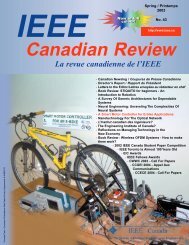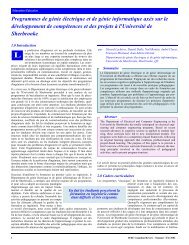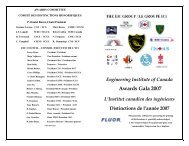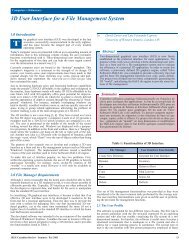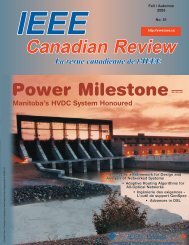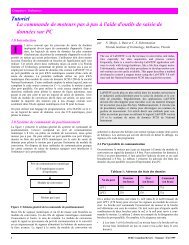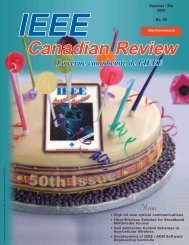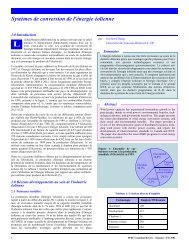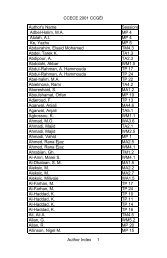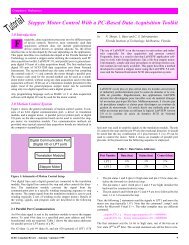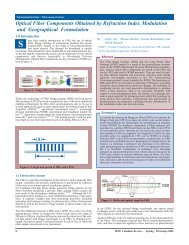Download Presentation [1.9MB PDF] - IEEE
Download Presentation [1.9MB PDF] - IEEE
Download Presentation [1.9MB PDF] - IEEE
Create successful ePaper yourself
Turn your PDF publications into a flip-book with our unique Google optimized e-Paper software.
Modeling and Control of a Cascaded Boost<br />
Converter for a Battery Electric Vehicle<br />
<br />
A. Ndtoungou, Ab. Hamadi, A. Missanda and K. Al-Haddad, Fellow member,<br />
<strong>IEEE</strong><br />
EPEC 2012 OCTOBER 10-12
Introduction<br />
contents<br />
Comparison between boost and cascade boost<br />
Modeling and control of cascade boost converter<br />
Space average model of the system<br />
Control law for output voltage control<br />
Design of the Proportional Integral (PI) controller<br />
Control Scheme of cascade boost for voltage control<br />
Simulation results<br />
Control of Battery current<br />
Simulation results<br />
Cascade boost converter used as non polluting converter<br />
Control scheme<br />
Simulation results<br />
Conclusion<br />
EPEC 2012 OCTOBER 10-12
INTRODUCTION<br />
<br />
I’s a new modeling technique of a cascade Boost converter;<br />
<br />
The nonlinear control is applied and gives good performances in grid side<br />
and in dc side.<br />
<br />
PI controller eliminates efficacy the steady state error of the dc bus voltages;<br />
<br />
The configuration proposed may be used to fast charging electrical vehicle<br />
battery by controlling the time charging;<br />
<br />
The configuration connected to the grid compensates current harmonics,<br />
reactive power, the THD of the grid current is less than 5%.<br />
EPEC 2012 OCTOBER 10-12
Comparison between Boost and cascade Boost<br />
Characteristics of boost converter and cascade boost converter<br />
The boost converter provides high currents, while the cascade boost converter<br />
achieves high voltage.<br />
The advantage of the high voltage of the cascade boost converter make it very<br />
suitable for high battery voltage charging current.<br />
EPEC 2012 OCTOBER 10-12
Modeling and control of cascade<br />
boost converter<br />
D 2<br />
iL 1<br />
L 1<br />
D 1<br />
i L 2<br />
v 1<br />
L 2<br />
D 3<br />
i o<br />
V C 1<br />
Q C2<br />
R vo<br />
in<br />
ON<br />
OFF<br />
i<br />
L1<br />
i<br />
L2<br />
i o<br />
i v<br />
L 1<br />
1<br />
L<br />
v 1<br />
i<br />
L2<br />
v<br />
L2<br />
i o<br />
V in<br />
L 1<br />
i<br />
C1<br />
v<br />
L1<br />
v<br />
C1<br />
i<br />
C2<br />
C<br />
v 1 L 2<br />
v<br />
L2<br />
v<br />
1<br />
C2<br />
C2<br />
R<br />
vo<br />
Vin<br />
L 1<br />
i<br />
C1<br />
v<br />
C1<br />
i<br />
C2<br />
L 2<br />
C v<br />
1 C2<br />
C2<br />
R<br />
vo<br />
EPEC 2012 OCTOBER 10-12
Space average model of the system<br />
( − )<br />
⎧ diL<br />
1 d<br />
1<br />
1<br />
⎪ = − vC<br />
+ V<br />
1<br />
⎪ dt L1 L1<br />
⎪ diL<br />
( − )<br />
2<br />
1 1 d<br />
⎪ = v C −<br />
1<br />
v 0<br />
⎪ dt L2 L2<br />
⎨<br />
⎪ dvC<br />
( 1 − d )<br />
1<br />
1<br />
⎪<br />
= iL<br />
− i<br />
1 L2<br />
dt C1 C1<br />
⎪<br />
⎪ dv 1<br />
⎪<br />
⎩<br />
o<br />
( 1 − d )<br />
= iL<br />
−<br />
2<br />
dt C RC<br />
2 2<br />
v<br />
o<br />
in<br />
EPEC 2012 OCTOBER 10-12
Control law for output voltage control :<br />
The dynamics of the output voltage is given by<br />
dv0<br />
1<br />
C + v = ( 1 − d ) i = u<br />
2 o L<br />
dt R<br />
2<br />
The control law is<br />
u u<br />
d = 1−<br />
i<br />
L 2<br />
The right term of this equation which is linear uses PI<br />
controller to regulate the voltage v0 and we extract the<br />
control law from this equation<br />
Where :<br />
i L2<br />
is the output of the controller PI<br />
is the current in inductance<br />
L 2<br />
EPEC 2012 OCTOBER 10-12
Design of the Proportional Integral<br />
(PI) controller<br />
k k +<br />
i<br />
= + = p s k<br />
G(s) k<br />
i<br />
p<br />
s s<br />
v0ref<br />
k s + k v<br />
p i u R 0<br />
s<br />
RC s + 1<br />
Closed loop output voltage regulation<br />
2<br />
G<br />
F<br />
⎧1 + Rk<br />
⎪ RC2<br />
⎨<br />
k<br />
( k p s + k i )<br />
1<br />
G 0 C 2<br />
= =<br />
1 + G ⎛ 1 + R k ⎞ k<br />
s + ⎜ ⎟ s +<br />
⎝ R C ⎠ C<br />
p<br />
0 2 p<br />
i<br />
⎪ i 2<br />
2<br />
= ω<br />
⎪<br />
0<br />
ki = ω0 C<br />
⎪<br />
⎩<br />
2<br />
C2<br />
⎩<br />
2 2<br />
= 2ξω0<br />
⎧<br />
1<br />
⎪k p = 2ξω0C2<br />
−<br />
⇔ ⎨<br />
R<br />
G<br />
1<br />
C<br />
( k p s + k i )<br />
2<br />
F =<br />
2 2<br />
s + 2 ξ ω 0 s + ω 0<br />
The choice of the PI controller is based<br />
on the desired performance of The<br />
damping factor ζ and pulsation ω 0 to<br />
give best response.<br />
EPEC 2012 OCTOBER 10-12
Control scheme of cascade boost for voltage<br />
control<br />
Output voltage<br />
d<br />
1<br />
u<br />
v 0<br />
i L2<br />
v 0 ref<br />
Output reference<br />
voltage is chosen<br />
by user<br />
EPEC 2012 OCTOBER 10-12
Cascade boost converter is able to<br />
regulate the output voltage<br />
The best choice of inductance L2 can<br />
give iL2 positive<br />
Simulation results<br />
For the high voltage, the boost<br />
converter is not able to regulate the<br />
output voltage<br />
Simulation results with cascade boost<br />
converter<br />
Simulation results with boost converter<br />
EPEC 2012 OCTOBER 10-12
CONTROL OF BATTERY CURRENT<br />
i L1<br />
D 2<br />
D 1<br />
i L2<br />
We test the cascade boost converter<br />
to charge the battery and to compare<br />
it with the boost converter<br />
L 1<br />
v 1<br />
L 2<br />
D 3<br />
i 0<br />
V in<br />
C 1<br />
Q<br />
C 2<br />
v 0<br />
Control law :<br />
1<br />
d = + u − V<br />
1<br />
( )<br />
1 1 in<br />
vC<br />
Control scheme of cascade boost for current control<br />
EPEC 2012 OCTOBER 10-12
Simulation results<br />
The both system gives the same performance to charge the battery<br />
The slight difference is observed in the boost converter that the current flowing in the<br />
inductance presents the high ripple current compared of the cascade boost converter<br />
Simulation results of cascade boost<br />
with battery current control<br />
Simulation results of boost with<br />
battery current control<br />
EPEC 2012 OCTOBER 10-12
CASCADE BOOST CONVERTER USED AS NON POLLUTING<br />
CONVERTER<br />
D 2<br />
iL 1<br />
D 1<br />
i L 2<br />
L 1<br />
v 1<br />
L 2<br />
D 3<br />
i o<br />
L f<br />
D a<br />
D c<br />
Vin<br />
C 1<br />
Q<br />
C2<br />
R vo<br />
D b<br />
D d<br />
Cascade boost<br />
Spectrum of the grid current<br />
EPEC 2012 OCTOBER 10-12
Control law<br />
Control Scheme<br />
Reference current : i L1ref<br />
1<br />
eq. 31 d = 1+ ( ui −Vin<br />
)<br />
v<br />
eq. 29<br />
C<br />
1<br />
i<br />
v ⎛<br />
u<br />
V<br />
i<br />
⎝<br />
0<br />
in<br />
L1ref = v + C<br />
V ⎜<br />
in v0<br />
1<br />
⎞<br />
⎟<br />
⎠<br />
EPEC 2012 OCTOBER 10-12
Grid current and grid voltage are in phase<br />
The THD of the grid current is less than 5%<br />
Simulation results<br />
During the output reference voltage variation we see that<br />
the output voltage well regulated , that the grid voltage<br />
and the grid current are in phase and sinusoidal<br />
Steady state response of a non polluting<br />
converter: upper - voltage and current<br />
source, lower - output voltage<br />
Dynamic response of a non polluting<br />
converter: upper- voltage and current<br />
source, lower- output voltage and its<br />
reference<br />
EPEC 2012 OCTOBER 10-12
CONCLUSION<br />
• The modeling of the cascade boost converter and the nonlinear<br />
control technique are presented.<br />
• The simulations results have shown good performances of the<br />
cascade Boost compared to the classical Boost converter.<br />
• The cascade Boost converter is suitable for high voltage battery.<br />
•The cascade Boost converter used as non polluting converter<br />
gives a THD less than 5% in the grid side.<br />
•The control of the battery current will help to control the<br />
charging time which may be used to fast charging electrical<br />
vehicle battery.<br />
EPEC 2012 OCTOBER 10-12
THANK YOU<br />
?<br />
EPEC 2012 OCTOBER 10-12


![Download Presentation [1.9MB PDF] - IEEE](https://img.yumpu.com/30185813/1/500x640/download-presentation-19mb-pdf-ieee.jpg)
![Download Presentation [1.9MB PDF] - IEEE](https://img.yumpu.com/51364167/1/190x146/download-presentation-19mb-pdf-ieee.jpg?quality=85)

![Download Presentation [950KB PDF] - IEEE](https://img.yumpu.com/50598566/1/190x146/download-presentation-950kb-pdf-ieee.jpg?quality=85)
